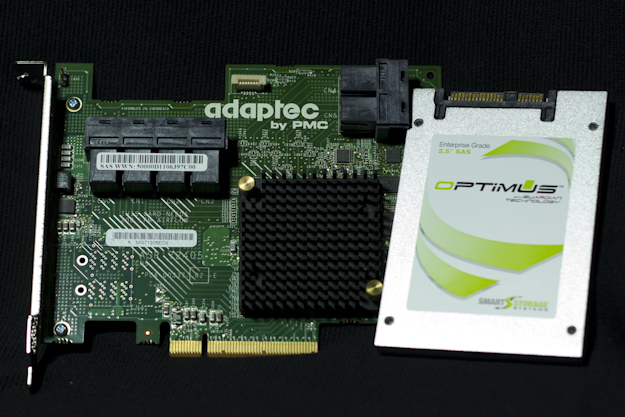When we first caught wind of the Adaptec Series 7 RAID adapters late last year, we were itching for the chance to get it in our test bench. But, in order to do the review justice, we needed SSDs. We needed a LOT of SSDs. We needed 24 SSDs.
Unfortunately, sampling even 4 or 8 SSDs at one time is often difficult. That is why we jumped at the chance to test out the Adaptec ASR-72405 with 24 x SMART Optimus 200GB SAS SSDs. Before we get going lets get a quick refresher on the SMART Optimus SAS SSD.
Back in 2012, we reviewed the 400GB version of the SMART Optimus and came away very impressed.
“Performance at steady state is fantastic, and what you see is what you get. If you see the specs on the box, you’re going to get similar performance out of the box and at steady state.”
For an enterprise drive, that is a great compliment. It also makes our jobs a lot easier, especially when looking at RAID adapters. With 500MB/s of sustained reads/writes and up to 100K IOPS, the SMART Optimus allows us to push the ASR-72405 to it’s limits.
As you can probably tell, it was a very happy day when that box arrived in the mail.
 The SSD Review The Worlds Dedicated SSD Education and Review Resource |
The SSD Review The Worlds Dedicated SSD Education and Review Resource | 


In many published reports a single optimus cannot provide latency performance within that tight of a range. These are obviously system cache results.
All caching was disabled, except for any write coalescing that the ROC was doing behind the scenes. You have to remember that the SSDs were not the bottleneck on the latency measurements, in fact, they were only going at 40% of their specified rates. Also, every test we have performed, and other sites as well, show the Optimus to be a very stable SSD. So, to your point, there is some amount of caching happening outside of the DRAM, but it very limited.
Any chance of reviewing the 71605Q, see how it stands up with 1 or 2TB worth of SSD cache and a much larger spinning array? Since it comes with the ZMCP (Adaptec’s version of BBU) you can even try it with write caching on.
I’d especially love to see maxCache 3.0 go head to head with LSI CacheCade Pro 2.0
Considering I actually already own the 71605Q, and bought practically “sight unseen” as there are still no reviews available it is nice to see that the numbers on the other cards in the line are living up to their claims.
Like I said in the review, I wish we had the time and resources to test out all combination, but we can’t get them all. I have both the 8 and 24-port versions and, yes, they always hit or exceed their published specifications. I agree, that would be a great head-to-head matchup, We have a lot of great RAID stories coming up, maybe we can fit it in. Thanks for the feedback!
Yeah after I posted that I started brainstorming all the possible valid combinations you could test with those two cards and there’s quite a few permutations… Also might not be too fair to the older LSI solution but it’s what they have available and I don’t know of any release schedule for CC 3.0 or next gen cards, so might not hurt to wait for those.
I guess the best case to test would be best case cache worst case spinners, so RAID-10/1E SSDs with RAID-6 HDDs. See how the two solutions do at overcoming some of the RAID-6 drawbacks esp the write penalty.
I’m guessing the results would probably be fairly similar to the LSI Nytro review but still would be interesting to see how up to 2TB of SMART Optimus would do with a 20TB array.
Nice! How did you manage to connect the two cards (X2)?
“..We were able to procure a second ASR-72405 and split the drives evenly across the two…”
See my comment
I’m assuming they made a stripe on each raid card and then did a software raid 0 stripe of the arrays into one volume. That would be why the processors showed 50% until under load.
Great review though that SSD has me worried for sustained enterprise usage.